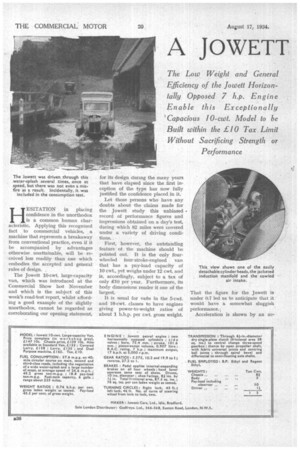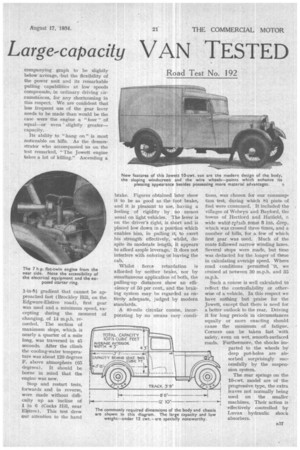jOWETT
Page 50

Page 51

Page 52

If you've noticed an error in this article please click here to report it so we can fix it.
Large-capacity VAN TESTED
Road Test No. 192
HESITATION in placing confidence in the unorthodox is a common human characteristic. Applying this recognized
fact to commercial vehicles, . a machine that represents a breakaway from conventional practice, even if it be accompanied by advantages otherwise unattainable, will be re ceived less readily than one which embodies the accepted and general rules of design.
The Jowett 10-cwt. large-capacity van, which was introduced at the Commercial Show last November and which is the subject of this week's road-test report, whilst affording a good example of the slightly unorthodox, cannot be regarded as corroborating our opening statement, for its design during the many years that have elapsed since the. first inception of the type has now fully justified the confidence placed in it.
• Let those persons who have any doubts about the claims made for the Jowett study this unbiased • record of performance figures and impressions obtained on a day's test, during which 82 miles were covered under a variety of driving condi tions. , • First, however, the outstanding feature of the machine should be pointed out. It is the only fourwheeled four-stroke-engined van that has a pay-load capacity of 10 cwt, yet weighs under 12 cwt, and is, accordingly, subject to a tax of only £10 per year. Furthermore, its body dimensions render it one of the largest.
It is usual for vets in the 5-cwt. and 10-cwt. classes to have engines giving power-to-weight ratios of about 1 b.h.p. per cwt, gross weight.
That the figure for the Jowett is
under 0.7 led us to anticipate that it ' would have a somewhat sluggish
performance.: Acceleration is shown by an ac companying graph to be slightly below average, but the flexibility of the power unit and its remarkable pulling capabilities at low speeds compensate, in ordinary driving circumstances, for any shortcoming in this respect. We are confident that less frequent use of the gear lever needs to be made than would be the case were the engine a " four " of equal—or even slightly greater—. capacity.
Its ability to "hang on " is most noticeable on hills. As the demonstrator who accompanied us on the test remarked, "The Jowett engine takes a lot of killing." Ascending a
1-in-Si gradient that cannot be ap proached fast (Brockley Hill, on the Edgware-Elstree road), first gear was used and a minimum speed, excepting during the moment of changing, of 14 m.p.h. recorded. The section of maximum slope, winchis nearly a quarter of a mile long, was traversed in 45 seconds. After the climb the cooling-water tempera ture was about 120 degrees F. above atmosphere (65 degrees). It should be borne in mind that the engine was new.
Stop and restart tests, forwards and in reverse, were made without difficulty up an incline of 1 in 6 (Cocks Hill, near Eistree). This test drew our attention to the band
brake. Figures obtained later show it to be as good as thefoot brake, and it is pleasant to use, having a feeling of rigidity by no means usual on light vehicles. The lever is on the driver's right, is short and is placed low down in a position which enables him, in pulling it, to exert his strength effectively, whilst, despite its moderate length, it appears' to afford ample leverage.' It does not interfere with entering or leaving the cab.
Whilst fierce retardation is afforded by neither brake, nor by simultaneous application of both, the pulling-up distances show an efficiency of 50 per cent., and the braking system may be regarded as entirely adequate, judged by modern standards.
A 40-mile circular course, incorporating by no Means easy condi
tions, was chosen for our consumption test, during which Si pints of fuel were consumed. It includedthe villages of Welwyn and Bayford, the towns of Hertford and Hatfield, a wide water-splash some 8 ins. deep, which was crossed three times, and a number of hills, for a few of which first gear was used. Much of the route followed narrow winding lanes. Several stops were made, but time was deducted for the longer of these in calculating average speed. Where road conditions permitted 'it, we cruised at between 30 m.p.h. and 35 m.p.h.
Such a course is well calculated to reflect the controllability or otherwise of a vehicle. In this respect we have nothing but praise for the Jowett, except that there is need for a better outlook to the rear. Driving it for long periods in circumstances equally or more exacting should cause the minimum of fatigue. Corners can be taken fast with safety, even on wet, smooth-surfaced roads. Furthermore, the shocks imparted to the wheels by deep pot-holes are absorbed surprisingly successfully by the suspension system.
The rear springs on the 10-cwt. model are of the progressive type, the extra leaves not normally being used on the smaller machines. Their action is effectively controlled by Luvax hydraulic shock absorbers.
A modification recently made is the shackling of the front springs to the dumb-iron ends instead of at the rear. This has the effect of moving the front axle slightly forwards as the springs are flattened and is claimed to enhance the effectiveness of the front brakes. Another new chassis feature is the use of wire wheels.
The large body was seen for the first time at Olympia last year, and its proportions and rounded back and sides, with the new sloping windscreen, are pleasing in appearance, apart from the increased capacity afforded.
The spare-wheel mounting is inside the van, partly to the right and partly to the rear of the driver's seat ; beside it are clipped the tyre pump and jack handle. The remainder of the tool kit is under the seat. If preferred, the wheel can be carried on the roof, as formerly, one of the roof sticks being reinforced for this purpose.
Although few changes have been incorporated, it is of interest -to re
cord that the machine we tested is actually one of the first 1935 models.
Mention should be made of the rear door fixing, . Operated in the usual way by the door handle, the two bolts, instead of moving apart to enter sockets in the roof and the floor, are
brought together, in closing the door, so that hooks formed on their ends engage wit h catches, which replace the usual sockets. Thus the likelihood of tffe doors bursting open is rendered extremely remote. Despite their low weight the bodies are well made ; that on the machine tested has a capacity of 1074 cubic ft., but struck us as possessing adequate strength.
The Jowett concern, besides listing several different types of standard van and lorry, supplies bodies for specialized trades.
A variety of colour schemes is offered, a small extra charge being quoted for painting each type.
From the point of view of maintenance, a two-cylindered engine has definite advantages over a "four," and the chassis in other respects is straightforward and simple. On the score of general economy this make of light goods vehicle stands almost unchallenged.
We are asked by Godfreys, Ltd., which concern supplied us with the vehicle for test, to state that the territory for which it is Jowett distributor has recently been increased, now including, besides London, Essex, Hertfordshire and parts of Kent, Surrey, Buckinghamshire and Berkshire.
10 20 30 40 50 60 70 60 90 100 FEET




























































































